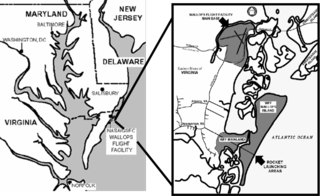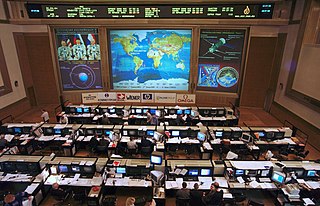Related Research Articles

The NASA Deep Space Network (DSN) is a worldwide network of U.S. spacecraft communication facilities, located in the United States (California), Spain (Madrid), and Australia (Canberra), that supports NASA's interplanetary spacecraft missions. It also performs radio and radar astronomy observations for the exploration of the Solar System and the universe, and supports selected Earth-orbiting missions. DSN is part of the NASA Jet Propulsion Laboratory (JPL). Similar networks are run by Russia, China, India, Japan and the European Space Agency.

Air Force Space Command (AFSPC) is a major command of the United States Air Force, with its headquarters at Peterson Air Force Base, Colorado. AFSPC supports U.S. military operations worldwide through the use of many different types of space operations. Operationally, AFSPC is an Air Force major command subordinate to U.S. Strategic Command (USSTRATCOM), a unified combatant command. As of 2019 it is the primary space force for the U.S. Armed Forces.

The Tracking and Data Relay Satellite System (TDRSS) is a network of American communications satellites and ground stations used by NASA for space communications. The system was designed to replace an existing network of ground stations that had supported all of NASA's manned flight missions. The prime design goal was to increase the time spacecraft were in communication with the ground and improve the amount of data that could be transferred. Many Tracking and Data Relay Satellites were launched in the 1980s and 1990s with the Space Shuttle and made use of the Inertial Upper Stage, a two-stage solid rocket booster developed for the shuttle. Other TDRS were launched by Atlas IIa and Atlas V rockets.
Orbital Sciences Corporation was an American company specializing in the design, manufacture and launch of small- and medium- class space and rocket systems for commercial, military and other government customers. In 2014 Orbital merged with Alliant Techsystems to create a new company called Orbital ATK, Inc., which in turn was purchased by Northrop Grumman in 2018.

Wallops Flight Facility (WFF), located on the Eastern Shore of Virginia, United States, approximately 100 miles (160 km) north-northeast of Norfolk, is operated by the Goddard Space Flight Center in Greenbelt, Maryland, primarily as a rocket launch site to support science and exploration missions for NASA and other Federal agencies. WFF includes an extensively instrumented range to support launches of more than a dozen types of sounding rockets; small expendable suborbital and orbital rockets; high-altitude balloon flights carrying scientific instruments for atmospheric and astronomical research; and, using its Research Airport, flight tests of aeronautical research aircraft, including unmanned aerial vehicles.

The interplanetary Internet is a conceived computer network in space, consisting of a set of network nodes that can communicate with each other. Communication would be greatly delayed by the great interplanetary distances, so the IPN needs a new set of protocols and technology that are tolerant to large delays and errors. Although the Internet as it is known today tends to be a busy network of networks with high traffic, negligible delay and errors, and a wired backbone, the interplanetary Internet is a store and forward network of internets that is often disconnected, has a wireless backbone fraught with error-prone links and delays ranging from tens of minutes to even hours, even when there is a connection.

A tracking and data relay satellite (TDRS) is a type of communications satellite that forms part of the Tracking and Data Relay Satellite System (TDRSS) used by NASA and other United States government agencies for communications to and from independent "User Platforms" such as satellites, balloons, aircraft, the International Space Station, and remote bases like the Amundsen-Scott South Pole Station. This system was designed to replace an existing worldwide network of ground stations that had supported all of NASA's crewed flight missions and uncrewed satellites in low-Earth orbits. The primary system design goal was to increase the amount of time that these spacecraft were in communication with the ground and improve the amount of data that could be transferred. These TDRSS satellites are all designed and built to be launched to and function in geosynchronous orbit, 35,786 km (22,236 mi) above the surface of the Earth.

Flight controllers are personnel who aid space flight by working in such Mission Control Centers as NASA's Mission Control Center or ESA's European Space Operations Centre. Flight controllers work at computer consoles and use telemetry to monitor various technical aspects of a space mission in real time. Each controller is an expert in a specific area and constantly communicates with additional experts in the "back room". The flight director, who leads the flight controllers, monitors the activities of a team of flight controllers, and has overall responsibility for success and safety.
The Indian Space Research Organisation (ISRO), over the years, has established a comprehensive global network of ground stations to provide Telemetry, Tracking and Command (TTC) support to satellite and launch vehicle missions. These facilities are grouped under ISRO Telemetry, Tracking and Command Network (ISTRAC) with its headquarters at Bangalore, India.

Space Flight Operations Facility (SFOF) is a control room and related communications equipment areas at the Jet Propulsion Laboratory in Pasadena, California. NASA's Deep Space Network is operated from this facility. The SFOF has monitored and controlled all interplanetary and deep space exploration for NASA and other international space agencies since 1963. The facility also acted as a backup communications facility for Apollo missions.
The Manned Space Flight Network was a set of tracking stations built to support the American Mercury, Gemini, Apollo, and Skylab space programs.

The Space Communications and Navigation (SCaN) program places the three prime NASA space communications networks, Space Network (SN), Near Earth Network (NEN), and the Deep Space Network (DSN), under one Management and Systems Engineering umbrella. It was established in 2006. It was previously known as the Space Communications & Data Systems (SCDS) Program.
The Near Earth Network provides orbital communications support for near-Earth orbiting customer platforms via various NASA ground stations.
The Network Control Center Data System (NCCDS) is an element of NASA's Space Network (SN) ground segment. Collocated with the White Sands Tracking and Data Relay Satellite System, the NCCDS is the operations control facility for the network. It schedules most Space Network elements and supporting elements and provides interfaces for planning, acquisition, control, and status of the Space Network. The NCCDS is the point-of-contact between customers and the Space Network for most scheduling and real-time performance. A customer may obtain Space Network support by submitting specific schedule requests to or establishing generic requirements with the NCCDS. The NCCDS translates customers’ requirements into specific TDRS communications and tracking events. Additionally, the NCCDS notifies affected customers of scheduled system outages so that Mission Operation Centers (MOCs) can properly plan mission activities. Upon MOC request, the NCCDS provides operational performance information on scheduled services during actual support to determine if conditions exist that will affect data quality.

The European Data Relay System (EDRS) system is a European constellation of state of the art GEO satellites that relay information and data between satellites, spacecraft, UAVs, and ground stations. The designers intend the system to provide almost full-time communication, even with satellites in low Earth orbit that often have reduced visibility from ground stations. It makes on-demand data available to, for example, rescue workers who want near-real-time satellite data of a crisis region.

The NASA (Ground) Communications System (NASCOM) manages terrestrial communications between ground stations, mission control centers, and other elements of spacecraft ground segments, providing worldwide, near real-time transmission of commands, telemetry, voice, and television signals. It is managed out of NASA's Goddard Space Flight Center in Greenbelt, Maryland.

The Joint Polar Satellite System (JPSS) is the latest generation of U.S. polar-orbiting, non-geosynchronous, environmental satellites. JPSS will provide the global environmental data used in numerical weather prediction models for forecasts, and scientific data used for climate monitoring. JPSS will aid in fulfilling the mission of the U.S. National Oceanic and Atmospheric Administration (NOAA), an agency of the Department of Commerce. Data and imagery obtained from the JPSS will increase timeliness and accuracy of public warnings and forecasts of climate and weather events, thus reducing the potential loss of human life and property and advancing the national economy. The JPSS is developed by the National Aeronautics and Space Administration (NASA) for the National Oceanic and Atmospheric Administration (NOAA), who is responsible for operation of JPSS. Three to five satellites are planned for the JPSS constellation of satellites. JPSS satellites will be flown, and the scientific data from JPSS will be processed, by the JPSS - Common Ground System (JPSS-CGS).

Laser communication in space is free-space optical communication in outer space.

A ground segment consists of all the ground-based elements of a spacecraft system used by operators and support personnel, as opposed to the space segment and user segment. The ground segment enables management of a spacecraft, and distribution of payload data and telemetry among interested parties on the ground. The primary elements of a ground segment are:
References
- Space Network Ground Segment Sustainment (SGSS) Mission System Requirements Document (MSRD). Section 3.6.1, NISN. NASA/GSFC: November 21, 2008